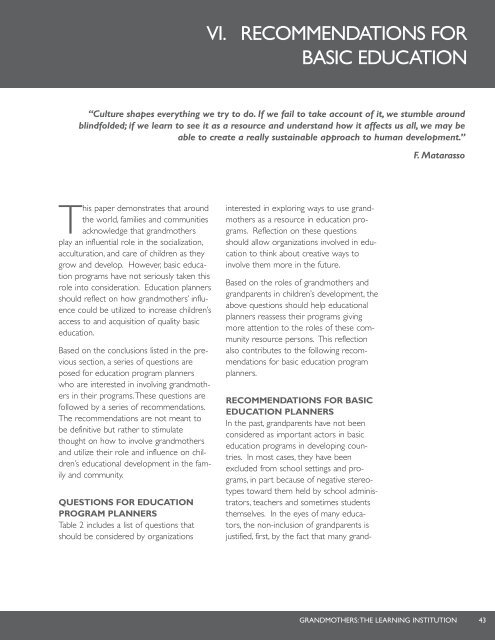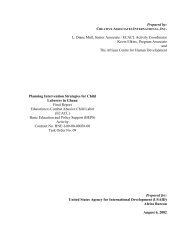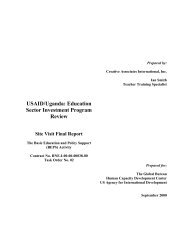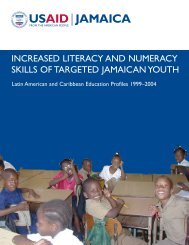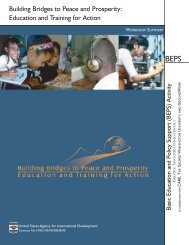Grandmothers: A Learning Institution - Basic Education and Policy ...
Grandmothers: A Learning Institution - Basic Education and Policy ...
Grandmothers: A Learning Institution - Basic Education and Policy ...
- No tags were found...
You also want an ePaper? Increase the reach of your titles
YUMPU automatically turns print PDFs into web optimized ePapers that Google loves.
VI. RECOMMENDATIONS FORBASIC EDUCATION“Culture shapes everything we try to do. If we fail to take account of it, we stumble aroundblindfolded; if we learn to see it as a resource <strong>and</strong> underst<strong>and</strong> how it affects us all, we may beable to create a really sustainable approach to human development.”F. MatarassoThis paper demonstrates that aroundthe world, families <strong>and</strong> communitiesacknowledge that gr<strong>and</strong>mothersplay an influential role in the socialization,acculturation, <strong>and</strong> care of children as theygrow <strong>and</strong> develop. However, basic educationprograms have not seriously taken thisrole into consideration. <strong>Education</strong> plannersshould reflect on how gr<strong>and</strong>mothers’ influencecould be utilized to increase children’saccess to <strong>and</strong> acquisition of quality basiceducation.Based on the conclusions listed in the previoussection, a series of questions areposed for education program plannerswho are interested in involving gr<strong>and</strong>mothersin their programs.These questions arefollowed by a series of recommendations.The recommendations are not meant tobe definitive but rather to stimulatethought on how to involve gr<strong>and</strong>mothers<strong>and</strong> utilize their role <strong>and</strong> influence on children’seducational development in the family<strong>and</strong> community.QUESTIONS FOR EDUCATIONPROGRAM PLANNERSTable 2 includes a list of questions thatshould be considered by organizationsinterested in exploring ways to use gr<strong>and</strong>mothersas a resource in education programs.Reflection on these questionsshould allow organizations involved in educationto think about creative ways toinvolve them more in the future.Based on the roles of gr<strong>and</strong>mothers <strong>and</strong>gr<strong>and</strong>parents in children’s development, theabove questions should help educationalplanners reassess their programs givingmore attention to the roles of these communityresource persons. This reflectionalso contributes to the following recommendationsfor basic education programplanners.RECOMMENDATIONS FOR BASICEDUCATION PLANNERSIn the past, gr<strong>and</strong>parents have not beenconsidered as important actors in basiceducation programs in developing countries.In most cases, they have beenexcluded from school settings <strong>and</strong> programs,in part because of negative stereotypestoward them held by school administrators,teachers <strong>and</strong> sometimes studentsthemselves. In the eyes of many educators,the non-inclusion of gr<strong>and</strong>parents isjustified, first, by the fact that many gr<strong>and</strong>GRANDMOTHERS:THE LEARNING INSTITUTION43


